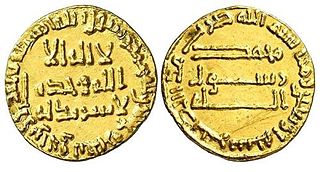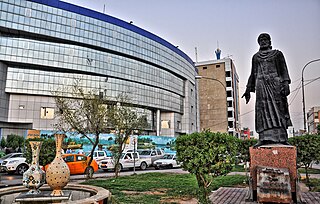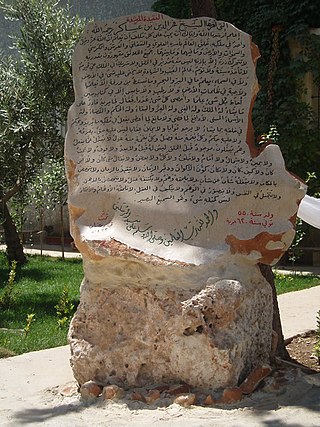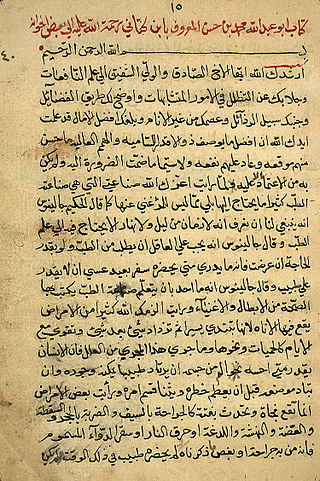
Abū Bakr al-Rāzī, c. 864 or 865–925 or 935 CE, often known as (al-)Razi or by his Latin name Rhazes, also rendered Rhasis, was a Persian physician, philosopher and alchemist who lived during the Islamic Golden Age. He is widely regarded as one of the most important figures in the history of medicine, and also wrote on logic, astronomy and grammar. He is also known for his criticism of religion, especially with regard to the concepts of prophethood and revelation. However, the religio-philosophical aspects of his thought, which also included a belief in five "eternal principles", are fragmentary and only reported by authors who were often hostile to him.

Abū Jaʿfar ʿAbd Allāh ibn Muḥammad al-Manṣūr usually known simply as by his laqab al-Manṣūr (المنصور) was the second Abbasid caliph, reigning from 136 AH to 158 AH succeeding his brother al-Saffah. He is known for founding the 'Round City' of Madinat al-Salam, which was to become the core of imperial Baghdad.

Abu Muslim Abd al-Rahman ibn Muslim al-Khurasani or Behzādān Pour Vandād Hormozd was a Persian general who led the Abbasid Revolution that toppled the Umayyad dynasty, leading to the establishment of the Abbasid Caliphate.
Abu Nasri Mansur ibn Ali ibn Iraq al-Jaʿdī was a Persian Muslim mathematician and astronomer. He is well known for his work with the spherical sine law.

Abū al-Wafāʾ Muḥammad ibn Muḥammad ibn Yaḥyā ibn Ismāʿīl ibn al-ʿAbbās al-Būzjānī or Abū al-Wafā Būzhjānī was a Persian mathematician and astronomer who worked in Baghdad. He made important innovations in spherical trigonometry, and his work on arithmetic for businessmen contains the first instance of using negative numbers in a medieval Islamic text.
Abu Mansur Daqiqi, better simply known as Daqiqi (دقیقی), was one of the most prominent Persian poets of the Samanid era. He was the first to undertake the creation of the national epic of Iran, the Shahnameh, but was killed in 977 after only completing 1,000 verses. His work was continued by his contemporary Ferdowsi, who would later become celebrated as the most influential figure in Persian literature.
Abu-Abdullah Muhammad ibn Īsa Māhānī was a Persian mathematician and astronomer born in Mahan, and active in Baghdad, Abbasid Caliphate. His known mathematical works included his commentaries on Euclid's Elements, Archimedes' On the Sphere and Cylinder and Menelaus' Sphaerica, as well as two independent treatises. He unsuccessfully tried to solve a problem posed by Archimedes of cutting a sphere into two volumes of a given ratio, which was later solved by 10th century mathematician Abū Ja'far al-Khāzin. His only known surviving work on astronomy was on the calculation of azimuths. He was also known to make astronomical observations, and claimed his estimates of the start times of three consecutive lunar eclipses were accurate to within half an hour.
Najib ad-Din Abu Hamid Muhammad ibn Ali ibn Umar Samarqandi was a 13th-century Persian physician from Samarqand.
Masʽud ibn Muhammad Sijzi was a Persian physician who lived before 1334CE in eastern Iran.
The tābiʿūn, "followers" or "successors", are the generation of Muslims who followed the companions (ṣaḥāba) of the Islamic prophet Muhammad, and thus received their teachings secondhand. A tābiʿ knew at least one ṣaḥābī. As such, they played an important part in the development of Islamic thought and knowledge, and in the political development of the early caliphate.

Abū Manṣūr ʿAbd al-Malik ibn Muḥammad ibn Ismāʿīl al-Thaʿālibī (961–1038), was a writer famous for his anthologies and collections of epigrams. As a writer of prose and verse in his own right, distinction between his and the work of others is sometimes lacking, as was the practice of writers of the time.

Abu Ismaïl Abdullah al-Harawi al-Ansari or Abdullah Ansari of Herat (1006–1088) also known as Pir-i Herat "Sage of Herat", was a Muslim Sufi saint who lived in Herat. Ansari was a commentator on the Qur'an, scholar of the Hanbali school of thought (madhhab), traditionalist, polemicist and spiritual master, known for his oratory and poetic talents in Arabic and Persian.

Utba ibn Ghazwan al-Mazini was a well-known companion of the Islamic prophet Muhammad. He was the seventh person to convert to Islam and participated in the hijra to Abyssinia, but returned to stay with Muhammad in Mecca before making the second hijrah to Medina. He fought at the battle of Badr (624), the battle of Uhud (625), the Battle of the Trench (627) and many others, including the battles of Yamamah.
Rawendis or Rwendi, a Persian sect that took its name from a town (Rawend) near Isfahan. Its origin is unknown, but they held Shi'ite doctrines. Under the year 158 Tabari says that a man of the Rwendis, called al-Ablaq, asserted that the spirit that was in Jesus was in Ali, then in the imams one after the other to Muhammad "al-Imām" and then finally to Ibrahim "al-Imām" ibn Muhammad; and that thus these were gods. Asad ibn Abdallah al-Qasri, then governor of Khorasan, put many of them to death. Under the year 135 the historian again mentions a rising of the Rwendis of Talaqan, and its suppression. Under 141 he gives a fuller account of them. They believed in metempsychosis, or the transmigration of souls, and asserted that the spirit of Adam was in Othman ibn Nahik; that the Lord who fed them and gave them drink was Abu Ja'far Abdallah ibn Muhammad Al-Mansur, and that al-Haitham ibn Muawiya was Gabriel. Accordingly they came to the palace of Mansur in Hashimiyya and began to hail him as lord. Mansur, however, secured their chiefs and threw them into prison. By means of a mock funeral they succeeded in reaching the prison and delivering their leaders. They then turned in wrath against Mansur and almost succeeded in capturing him, but were defeated and slain by al-Haitham.

Abū Manṣūr ʿAbd al-Qāhir ibn Ṭāhir bin Muḥammad bin ʿAbd Allāh al-Tamīmī al-Shāfiʿī al-Baghdādī was an Arab Shafi'i scholar, Usul Imam, heresiologist and mathematician.

Abu Abd Allah Muhammad ibn al-Husayn Ibn al-Kattani al-Madhiji (951–1029), sometimes nicknamed "al-Mutatabbib", was a well-known Arab scholar, philosopher, physician, astrologer, man of letters, and poet.
Tazkirat al-Awliyā – variant transliterations: Tazkirat al-Awliyā`, Tadhkirat al-Awliya, Tazkerat-ol-Owliya, Tezkereh-i-Evliā etc., – is a hagiographic collection of ninety-six Sufi saints and their miracles (Karamat) by the twelfth–thirteenth-century Persian poet and mystic, Farīd al-Dīn ‘Aṭṭar. ‘Aṭṭar's only surviving prose work comprises 72-chapters, beginning with the life of Jafar Sadiq, the Sixth Shia Imam, and ending with the Sufi Martyr, Mansur Al-Hallaj's.
Abu Salih Mansur was a Samanid prince, who served as governor during the reign of his uncle Isma'il ibn Ahmad, his cousin Ahmad Samani, and Nasr II.
Najm ad-Dīn Abū Ḥafṣ 'Umar ibn Muḥammad an-Nasafī was a Muslim jurist, theologian, mufassir, muhaddith and historian. A Persian scholar born in present-day Uzbekistan, he wrote mostly in Arabic.
Abū ʿAbdullāh Muḥammad bin Isḥāq Ibn Manda was an eminent Isfahani Sunni Hadith scholar of Persian origin.








